Multiscale Superpixelwise Locality Preserving Projection for Hyperspectral Image Classification
Abstract
:1. Introduction
2. Related Work and Background
2.1. Locality Preserving Projection
2.2. Region Covariance Descriptor
3. Proposed Method
3.1. Determination of Manifold Local Homogeneity with Multiscale Superpixel Segmentation
3.2. Divide-and-Conquer-Based LPP Classification
| Algorithm 1 MSuperLPP |
| Input: HSI ; scale set obtained by (8); window size . |
| Extract spectral-spatial covariance features using (5) and perform PCA to extract the first principle component . |
| for i = 1 to S do |
| Segment into homogeneous subregions using ERS with ; |
| for j = 1 to do |
| Perform LPP in each subregion , where the spectral-spatial covariance features are used to search for the k nearest neighbors. |
| end for |
| Combine the low-dimensional features of all the subregions on the same scale to form the low-dimensional data on this scale. Perform classification on the scales i to get preliminary output . |
| end for |
| Aggregate the classification results using (10) and (11). |
| Output: Final classification result T. |
4. Experimental Results
5. Conclusions
Author Contributions
Funding
Conflicts of Interest
References
- He, L.; Li, J.; Liu, C.Y.; Li, S.T. Recent advances on spectral—Spatial hyperspectral image classification: An overview and new guidelines. IEEE Trans. Geosci. Remote Sens. 2018, 56, 1579–1597. [Google Scholar] [CrossRef]
- Chang, C.I. Hyperspectral Data Exploitation: Theory And Applications; John Wiley & Sons: Hoboken, NJ, USA, 2007. [Google Scholar]
- Qiu, Z.; Chen, J.; Zhao, Y.; Zhu, S.; He, Y.; Zhang, C. Variety identification of single rice seed using hyperspectral imaging combined with convolutional neural network. Appl. Sci. 2018, 8, 212. [Google Scholar] [CrossRef]
- Hughes, G. On the mean accuracy of statistical pattern recognizers. IEEE Transa. Inf. Theory 1968, 14, 55–63. [Google Scholar] [CrossRef]
- Thenkabail, P.S.; Gumma, M.K.; Teluguntla, P.; Mohammed, I.A. Hyperspectral remote sensing of vegetation and agricultural crops. Photogramm. Eng. Remote Sens. 2014, 80, 697–723. [Google Scholar]
- Jiménez, L.O.; Rivera-Medina, J.L.; Rodríguez-Díaz, E.; Arzuaga-Cruz, E.; Ramírez-Vélez, M. Integration of spatial and spectral information by means of unsupervised extraction and classification for homogenous objects applied to multispectral and hyperspectral data. IEEE Trans. Geosci. Remote Sens. 2005, 43, 844–851. [Google Scholar] [CrossRef]
- Ni, D.; Ma, H.B. Classification of hyperspectral image based on sparse representation in tangent space. IEEE Geosci. Remote Sens. Lett. 2015, 12, 786–790. [Google Scholar]
- Shao, Z.F.; Zhang, L. Sparse dimensionality reduction of hyperspectral image based on semi-supervised local Fisher discriminant analysis. Int. J. Appl. Earth Obs. Geoinf. 2014, 31, 122–129. [Google Scholar] [CrossRef]
- Zhang, L.P.; Zhong, Y.F.; Huang, B.; Gong, J.Y.; Li, P.X. Dimensionality reduction based on clonal selection for hyperspectral imagery. IEEE Trans. Geosci. Remote Sens. 2007, 45, 4172–4186. [Google Scholar] [CrossRef]
- Mojaradi, B.; Abrishami-Moghaddam, H.; Zoej, M.J.V.; Duin, R.P. Dimensionality reduction of hyperspectral data via spectral feature extraction. IEEE Trans. Geosci. Remote Sens. 2009, 47, 2091–2105. [Google Scholar] [CrossRef]
- Duda, R.O.; Hart, P.E.; Stork, D.G. Pattern Classification; John Wiley & Sons: Hoboken, NJ, USA, 2001. [Google Scholar]
- Fukunaga, K. Introduction to Statistical Pattern Recognition; Elsevier: Amsterdam, The Netherlands, 1990. [Google Scholar]
- Wold, S.; Esbensen, K.; Geladi, P. Principal component analysis. Chemom. Intell. Lab. Syst. 1987, 2, 37–52. [Google Scholar] [CrossRef]
- Bandos, T.V.; Bruzzone, L.; Camps-Valls, G. Classification of hyperspectral images with regularized linear discriminant analysis. IEEE Trans. Geosci. Remote Sens. 2009, 47, 862–873. [Google Scholar] [CrossRef]
- He, X.F.; Niyogi, P. Locality preserving projections. In Proceedings of the Annual Conference on Neural Information Processing Systems, Vancouver, BC, Canada, 8–13 December 2003; pp. 153–160. [Google Scholar]
- Wang, Z.Y.; He, B.B. Locality perserving projections algorithm for hyperspectral image dimensionality reduction. In Proceedings of the International Conference on Geoinformatics, Shanghai, China, 24–26 June 2011; pp. 1–4. [Google Scholar]
- Deng, Y.J.; Li, H.C.; Pan, L.; Emery, W.J. Tensor locality preserving projection for hyperspectral image classification. In Proceedings of the IEEE International Geoscience and Remote Sensing Symposium, Fort Worth, TX, USA, 23–28 July 2017; pp. 771–774. [Google Scholar]
- Zhai, Y.; Zhang, L.; Wang, N.; Guo, Y.; Cen, Y.; Wu, T.; Tong, Q. A modified locality-preserving projection approach for hyperspectral image classification. IEEE Geosci. Remote Sens. Lett. 2016, 13, 1059–1063. [Google Scholar] [CrossRef]
- Wang, R.; Nie, F.; Hong, R.; Chang, X.; Yang, X.; Yu, W. Fast and orthogonal locality preserving projections for dimensionality reduction. IEEE Trans. Image Process. 2017, 26, 5019–5030. [Google Scholar] [CrossRef]
- Roweis, S.T.; Saul, L.K. Nonlinear dimensionality reduction by locally linear embedding. Science 2000, 290, 2323–2326. [Google Scholar] [CrossRef]
- Tenenbaum, J.B.; De, S.V.; Langford, J.C. A global geometric framework for nonlinear dimensionality reduction. Science 2000, 290, 2319–2323. [Google Scholar] [CrossRef]
- Zhang, Z.Y.; Zha, H.Y. Nonlinear dimension reduction via local tangent space alignment. In Proceedings of the International Conference on Intelligent Data Engineering and Automated Learning, Hong Kong, China, 21–23 March 2003; pp. 477–481. [Google Scholar]
- Sun, H.; Ren, J.; Zhao, H.; Yan, Y.; Zabalza, J.; Marshall, S. Superpixel based feature specific sparse representation for spectral-spatial classification of hyperspectral images. Remote Sens. 2019, 11, 536. [Google Scholar] [CrossRef]
- Duan, W.; Li, S.; Fang, L. Spectral-spatial hyperspectral image classification using superpixel and extreme learning machines. In Proceedings of the Chinese Conference on Pattern Recognition, Changsha, China, 17–19 November 2014; pp. 159–167. [Google Scholar]
- Zhan, T.; Sun, L.; Xu, Y.; Yang, G.; Zhang, Y.; Wu, Z. Hyperspectral classification via superpixel kernel learning-based low rank representation. Remote Sens. 2018, 10, 1639. [Google Scholar] [CrossRef]
- Deng, Y.J.; Li, H.C.; Pan, L.; Shao, L.Y.; Du, Q.; Emery, W.J. Modified tensor locality preserving projection for dimensionality reduction of hyperspectral images. IEEE Geosci. Remote Sens. Lett. 2018, 15, 277–281. [Google Scholar] [CrossRef]
- Fang, L.; He, N.; Li, S.; Plaza, A.J.; Plaza, J. A new spatial-spectral feature extraction method for hyperspectral images using local covariance matrix representation. IEEE Trans. Geosci. Remote Sens. 2018, 56, 3534–3546. [Google Scholar] [CrossRef]
- He, N.; Paoletti, M.E.; Fang, L.; Li, S.; Plaza, A.; Plaza, J. Feature extraction with multiscale covariance maps for hyperspectral image classification. IEEE Trans. Geosci. Remote Sens. 2018, 57, 1–15. [Google Scholar] [CrossRef]
- Qiao, L.; Chen, S.; Tan, X. Sparsity preserving projections with applications to face recognition. Pattern Recogn. 2010, 43, 331–341. [Google Scholar] [CrossRef] [Green Version]
- Tuzel, O.; Porikli, F.; Meer, P. Pedestrian detection via classification on riemannian manifolds. IEEE Trans. Pattern Anal. Mach. Intell. 2008, 30, 1713–1727. [Google Scholar] [CrossRef]
- Xie, X.F.; Yu, Z.L.; Gu, Z.H.; Zhang, J.; Cen, L.; Li, Y.Q. Bilinear regularized locality preserving learning on Riemannian graph for motor imagery BCI. IEEE Trans. Neural Syst. Rehabil. Eng. 2018, 26, 698–708. [Google Scholar] [CrossRef]
- Wang, R.P.; Guo, H.M.; Davis, L.S.; Dai, Q.H. Covariance discriminative learning: A natural and efficient approach to image set classification. In Proceedings of the IEEE Conference on Computer Vision and Pattern Recognition, Providence, RI, USA, 16–21 June 2012; pp. 2496–2503. [Google Scholar]
- Guo, B.; Gunn, S.R.; Damper, R.I.; Nelson, J.D.B. Customizing kernel functions for SVM-based hyperspectral image classification. IEEE Trans. Image Process. 2008, 17, 622–629. [Google Scholar] [CrossRef]
- Melgani, F.; Bruzzone, L. Classification of hyperspectral remote sensing images with support vector machines. IEEE Trans. Geosci. Remote Sens. 2004, 42, 1778–1790. [Google Scholar] [CrossRef] [Green Version]
- Ma, L.; Crawford, M.M.; Tian, J. Local Manifold Learning-Based k-Nearest-Neighbor for Hyperspectral Image Classification. IEEE Trans. Geosci. Remote Sens. 2010, 48, 4099–4109. [Google Scholar] [CrossRef]
- Liu, M.Y.; Tuzel, O.; Ramalingam, S.; Chellappa, R. Entropy rate superpixel segmentation. In Proceedings of the IEEE Conference on Computer Vision and Pattern Recognition, Colorado Springs, CO, USA, 20–25 June 2011; pp. 2097–2104. [Google Scholar]
- Jiang, J.J.; Ma, J.Y.; Chen, C.; Wang, Z.Y.; Cai, Z.H.; Wang, L.Z. SuperPCA: A superpixelwise PCA approach for unsupervised feature extraction of hyperspectral imagery. IEEE Trans. Geosci. Remote Sens. 2018, 56, 4581–4593. [Google Scholar] [CrossRef]
- Bishop, C.M. Pattern Recognition and Machine Learning; Springer: New York, NY, USA, 2006. [Google Scholar]
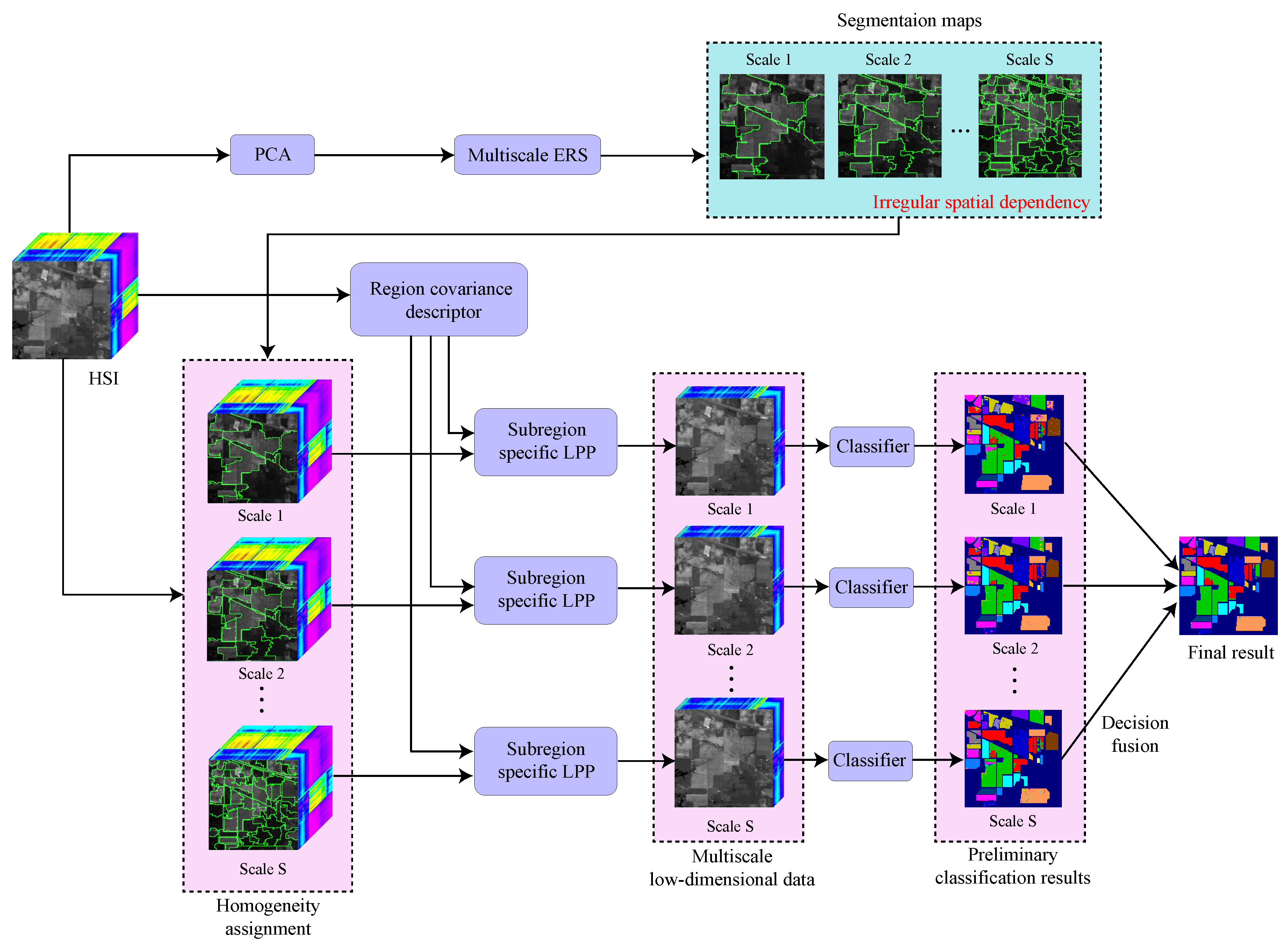
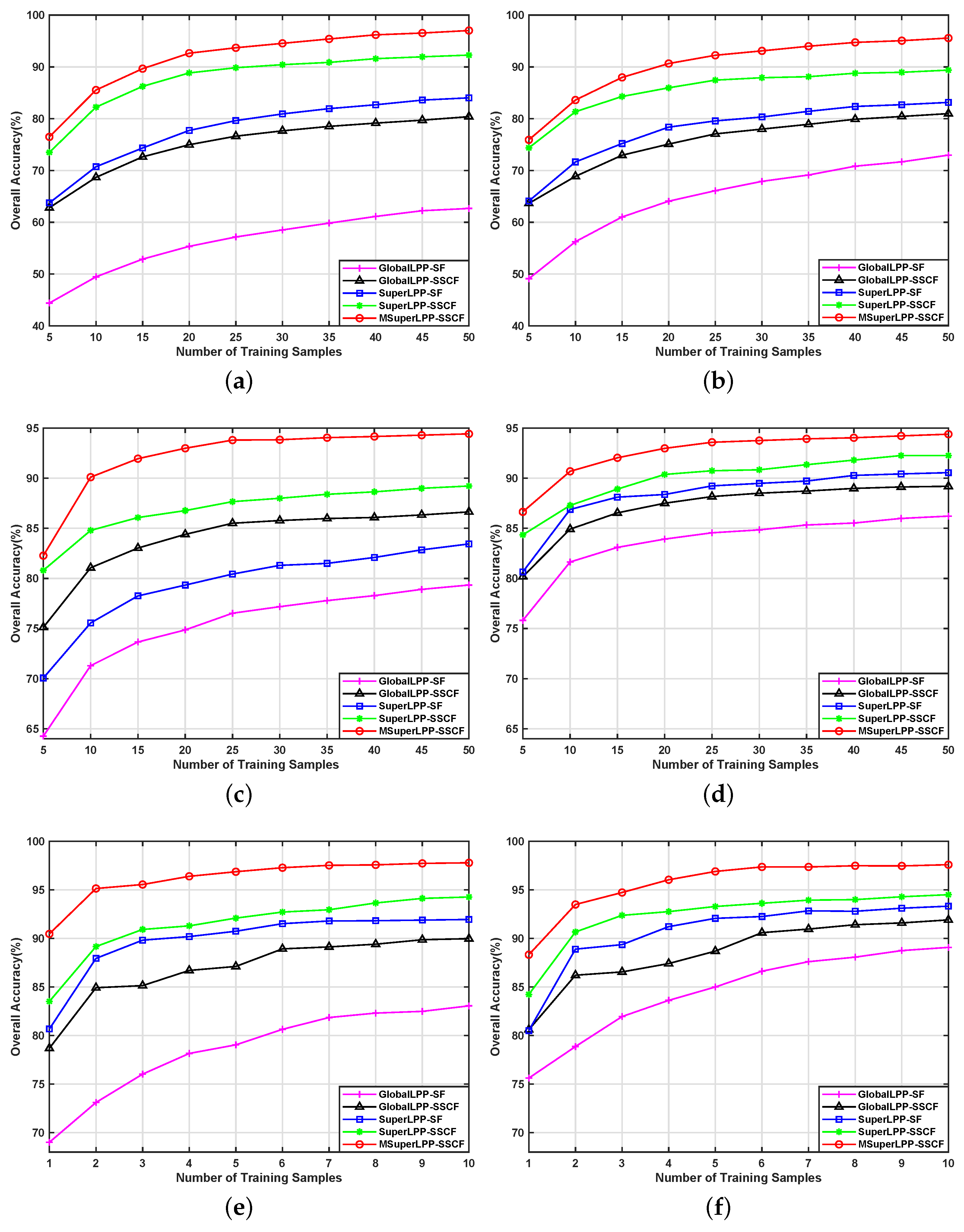
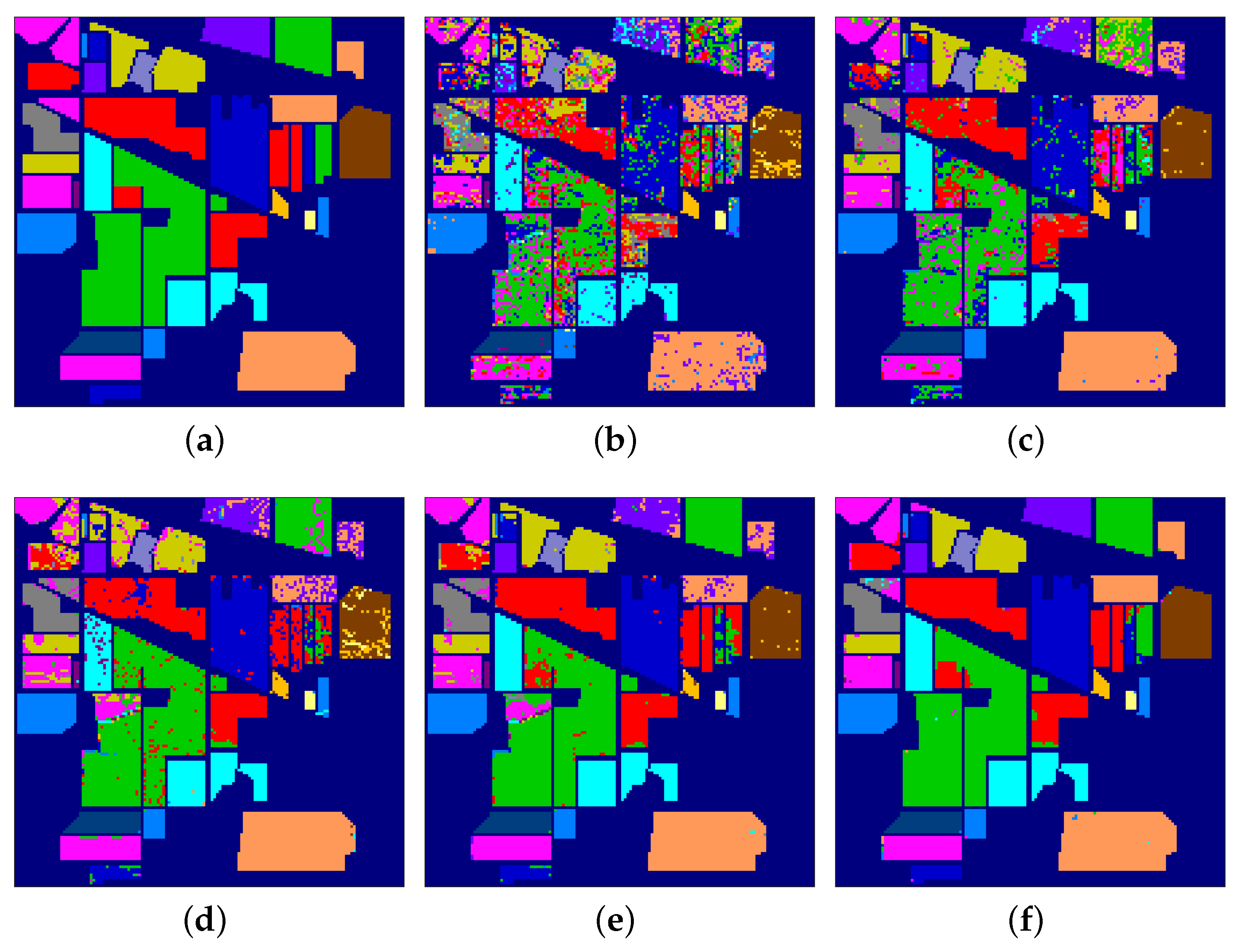
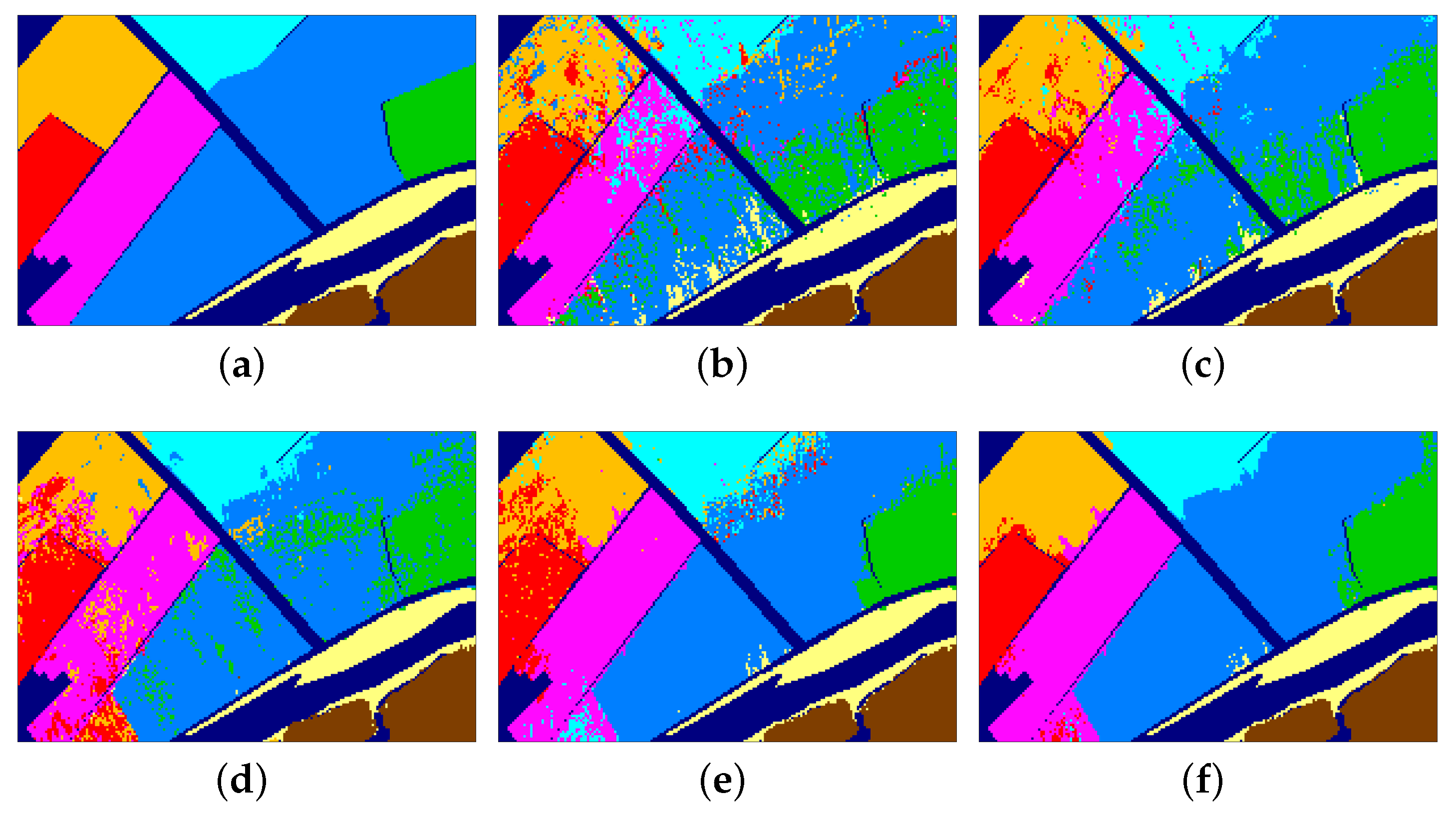
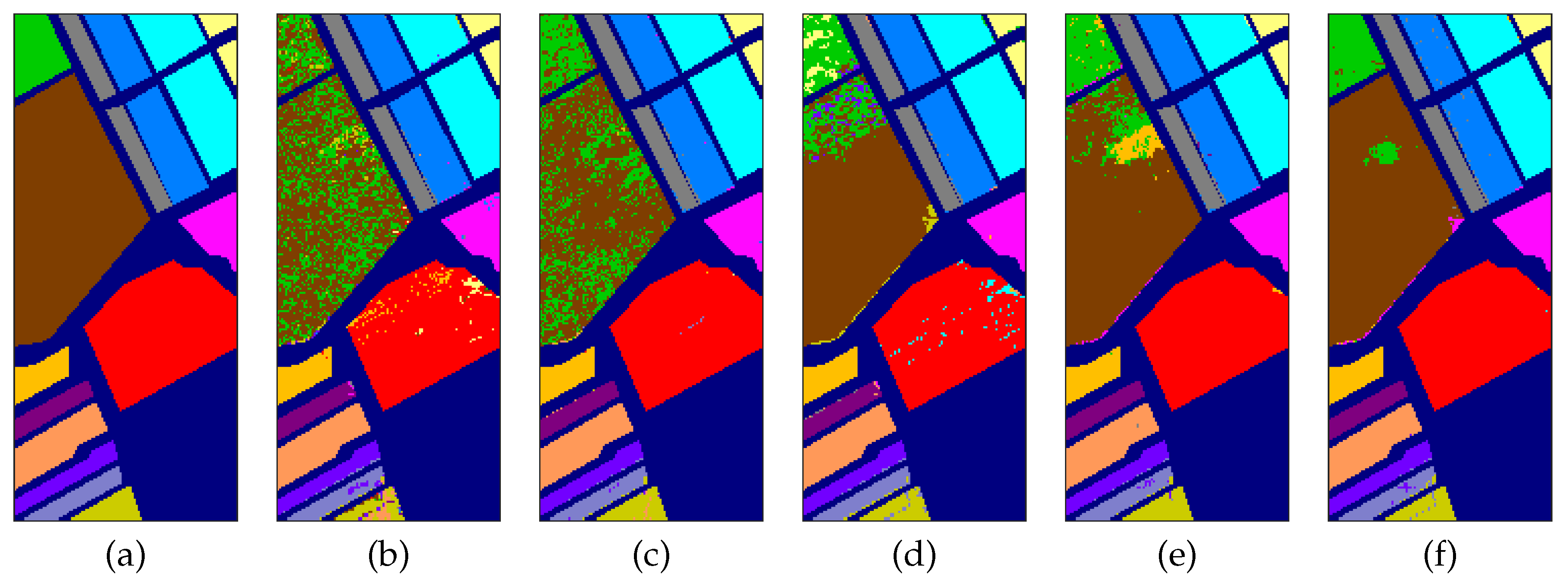
| Training Size | 5 | 10 | 30 | 50 | ||||
|---|---|---|---|---|---|---|---|---|
| Classifier | NN | SVM | NN | SVM | NN | SVM | NN | SVM |
| GlobalLPP-SF | 44.40 | 49.11 | 49.47 | 56.26 | 58.52 | 67.90 | 62.67 | 72.96 |
| GlobalLPP-SSCF | 62.81 | 63.65 | 68.67 | 68.87 | 77.66 | 77.99 | 80.39 | 80.98 |
| SuperLPP-SF | 63.74 | 64.10 | 70.73 | 71.65 | 80.92 | 80.33 | 84.03 | 83.14 |
| SuperLPP-SSCF | 73.50 | 74.37 | 82.23 | 81.35 | 90.43 | 87.91 | 92.28 | 89.38 |
| MSuperLPP | 76.49 | 75.91 | 85.53 | 83.60 | 94.55 | 93.10 | 97.02 | 95.57 |
| Training Size | 5 | 10 | 30 | 50 | ||||
|---|---|---|---|---|---|---|---|---|
| Classifier | NN | SVM | NN | SVM | NN | SVM | NN | SVM |
| GlobalLPP-SF | 64.26 | 75.81 | 71.29 | 81.64 | 77.18 | 84.84 | 79.34 | 86.21 |
| GlobalLPP-SSCF | 75.12 | 80.18 | 81.06 | 84.92 | 85.77 | 88.50 | 86.63 | 89.19 |
| SuperLPP-SF | 70.06 | 80.65 | 75.56 | 86.88 | 81.30 | 89.48 | 83.44 | 90.55 |
| SuperLPP-SSCF | 80.81 | 84.34 | 84.79 | 87.28 | 88.00 | 90.83 | 89.22 | 92.26 |
| MSuperLPP | 82.27 | 86.64 | 90.10 | 90.68 | 93.83 | 93.75 | 94.42 | 94.39 |
| Training Size | 1 | 3 | 5 | 10 | ||||
|---|---|---|---|---|---|---|---|---|
| Classifier | NN | SVM | NN | SVM | NN | SVM | NN | SVM |
| GlobalLPP-SF | 69.00 | 75.61 | 76.02 | 81.95 | 79.04 | 85.00 | 83.05 | 89.07 |
| GlobalLPP-SSCF | 78.69 | 80.60 | 85.14 | 86.55 | 87.11 | 88.69 | 89.97 | 91.91 |
| SuperLPP-SF | 80.67 | 80.51 | 89.82 | 89.36 | 90.74 | 92.06 | 91.95 | 93.32 |
| SuperLPP-SSCF | 81.77 | 84.23 | 90.92 | 92.37 | 91.97 | 93.28 | 93.82 | 94.50 |
| MSuperLPP | 90.46 | 88.32 | 95.55 | 94.73 | 96.87 | 96.89 | 97.78 | 97.59 |
© 2019 by the authors. Licensee MDPI, Basel, Switzerland. This article is an open access article distributed under the terms and conditions of the Creative Commons Attribution (CC BY) license (http://creativecommons.org/licenses/by/4.0/).
Share and Cite
He, L.; Chen, X.; Li, J.; Xie, X. Multiscale Superpixelwise Locality Preserving Projection for Hyperspectral Image Classification. Appl. Sci. 2019, 9, 2161. https://doi.org/10.3390/app9102161
He L, Chen X, Li J, Xie X. Multiscale Superpixelwise Locality Preserving Projection for Hyperspectral Image Classification. Applied Sciences. 2019; 9(10):2161. https://doi.org/10.3390/app9102161
Chicago/Turabian StyleHe, Lin, Xianjun Chen, Jun Li, and Xiaofeng Xie. 2019. "Multiscale Superpixelwise Locality Preserving Projection for Hyperspectral Image Classification" Applied Sciences 9, no. 10: 2161. https://doi.org/10.3390/app9102161
APA StyleHe, L., Chen, X., Li, J., & Xie, X. (2019). Multiscale Superpixelwise Locality Preserving Projection for Hyperspectral Image Classification. Applied Sciences, 9(10), 2161. https://doi.org/10.3390/app9102161






